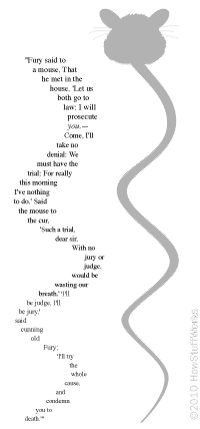Visual Effects in Poetry
Just as poets can use sound techniques like onomatopoeia to create auditory imagery, they can also enlist visual techniques to help create visual imagery, or the sense of how something looks. Most of the time, this is done with descriptive language that gives you a mental image of something, but another clever way that poets can create visual imagery is with visual effects, such as altering the poem's physical shape or placement on the page, or adding illustrations.
Word placement, line placement, line breaks -- these all can affect the visual imagery or even the meaning of the poem. One interesting example of this is concrete poetry, or shape poetry, where the words or lines of the poem actually make a picture or visually reflect what the poem is about. In concrete poetry, the words are arranged so that when you look at it as a whole, you can see an image formed by the placement of the poem's parts.
Advertisement
A famous example of concrete poetry comes from Lewis Carroll's "Alice's Adventures in Wonderland." In the story, a mouse tells Alice his "long and sad tale," which in the book itself is written as a shape poem. The words in the poem are placed so that the poem looks to be in the shape of a mouse's tail.
Other structural elements might be a bit more subtle. Acrostics, for example, are poems with hidden messages. In a basic acrostic, the first letters of each line might together spell out a word or a phrase. Acrostics that are more complicated might make the hidden message difficult to find by putting the essential letters elsewhere.
Other ways poems can make use of visual elements are by using fancy lettering, like calligraphy, or by including pictures on the page with the poem. Sometimes, the illustration enhances the meaning of the poem. One modern poet, Shel Silverstein, included illustrations with almost all of his poems. Sometimes, the poem itself could be vague or difficult to understand without looking at the picture that goes along with it. With some poems, however, the illustrations may just be ornamental.
So far, we've talked about sound effects, structural effects and visual effects, but another important part of creating a poem is deciding on its content, or what the poem is actually saying. In the next section, we'll look at how writing a poem can, in many ways, be similar to writing a story.
